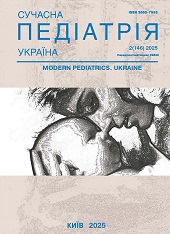Associative relationships of macro- and micronutrient levels in children with atopic dermatitis on BLW complementary feeding
DOI:
https://doi.org/10.15574/SP.2025.2(146).2025Keywords:
baby-led weaning, atopic dermatitis, macronutrients, micronutrients, childrenAbstract
Baby-led weaning (BLW) is a modern complementary feeding method in which the child independently manages the process of eating solid foods. Despite the growing popularity of BLW, there remain debates regarding whether infants consume adequate amounts of age-appropriate macro- and micronutrients, meet the energy needs of their growing bodies, and the potential risks of developing food allergies, particularly in children with manifestations of atopic dermatitis (AD).
Aim - to investigate the potential associations between levels of iron, calcium, total protein metabolism, and the manifestations of AD in infants on BLW complementary feeding.
Materials and methods. The study included 90 children who started BLW complementary feeding at six months of age. They were divided into three groups of 30 children each: the Group 1 - children on BLW with clinical manifestations of AD, the Group 2 - healthy children on BLW with a complicated family history of atopy, the Group 3 - healthy children on BLW without a complicated family history of atopy. The manifestations and severity of AD were evaluated using the Hanifin and Rajka criteria and the SCORAD index. Biological material was analyzed twice: before starting complementary feeding and six months after its introduction.
Results. In children with AD and those predisposed to atopy, a significant decrease in calcium and iron levels was observed after six months of BLW complementary feeding. Overall, there was a 10% increase in the prevalence of AD manifestations among the studied groups. A one-way analysis of variance did not reveal a significant association between iron levels and the presence/severity of AD. However, a significant moderate negative correlation was identified between calcium levels and the SCORAD severity score after six months of BLW complementary feeding.
Conclusions. The findings demonstrated associative relationships between micronutrient levels and AD manifestations in children on BLW complementary feeding. Confirmation of these results through further studies with larger cohorts of children on BLW could highlight the need for dietary adjustments, particularly for children with AD manifestations or a family history of atopy.
The study was conducted in accordance with the principles of the Declaration of Helsinki. The study protocol was approved by the Local Ethics Committee for all participants. Informed consent was obtained from patients (parents of children or their guardians).
There was no conflict of interest.
References
Brown SJ. (2021). What have we learned from GWAS for atopic dermatitis? J. Invest. Dermatol. 141: 19-22. https://doi.org/10.1016/j.jid.2020.05.100; PMid:32526212
Budu-Aggrey A, Kilanowski A, Sobczyk MK et al. (2023). European and multi-ancestry genome-wide association meta-analysis of atopic dermatitis highlights importance of systemic immune regulation. Nat Commun. 14(1): 6172.
D'Auria E, Bergamini M, Staiano A, Banderali G, Pendezza E, Penagini F et al. (2018). Baby-led weaning: what a systematic review of the literature adds on. Ital J Pediatr. 44: 49. https://doi.org/10.1186/s13052-018-0487-8; PMid:29724233 PMCid:PMC5934812
Giovannini M, Bolis M, Barni S, Liccioli G, Sarti L, Morelli S et al. (2023). Pearls and Pitfalls of Weaning an Infant with Severe Atopic Dermatitis and Sensitization/Allergy to FoodJ Clin Med. 12(12): 3889. https://doi.org/10.3390/jcm12123889; PMid:37373584 PMCid:PMC10298914
Hammond CM, White D, Tomic J et al. (2007). Extracellular calcium sensing promotes human B-cell activation and function. Blood. 110: 3985-3995. https://doi.org/10.1182/blood-2007-05-088468; PMid:17724142
Hanifin JM, Rajka G. (1980). Diagnostic features of atopic dermatitis Acta Dermatol Venereol. 92: 44-47. https://doi.org/10.2340/00015555924447
Hildebrand H, Simons E, Kozyrskyj AL, Becker AB, Protudjer JL. (2019). Calcium Intake in Children with Eczema and/or Food Allergy: A Prospective Cohort Study. Nutrients. 11(12): 3039. https://doi.org/10.3390/nu11123039; PMid:31842448 PMCid:PMC6950300
Lamprecht SA, Lipkin M. (2003). Chemoprevention of colon cancer by calcium, vitamin D and folate: molecular mechanisms. Nat Rev Cancer. 3: 601-614. https://doi.org/10.1038/nrc1144; PMid:12894248
Miyake Y, Sasaki S, Tanaka K, Hirota Y. (2010). Dairy food, calcium and vitamin D intake in pregnancy, and wheeze and eczema in infants European Respiratory Journal. 35: 1228-1234. https://doi.org/10.1183/09031936.00100609; PMid:19840962
Morison BJ, Heath AM, Haszard JJ, Hein K, Fleming EA, Daniels L et al. (2018). Impact of a modified version of baby-led weaning on dietary variety and food preferences in infants. Nutrients. 10(8): 1092. https://doi.org/10.3390/nu10081092; PMid:30111722 PMCid:PMC6115843
Pearce Jo, Langley-Evans SC. (2022). Comparison of food and nutrient intake in infants aged 6-12 months, following baby-led or traditional weaning: A cross-sectional study J Hum Nutr Diet. 35(2): 310-324. https://doi.org/10.1111/jhn.12947; PMid:34476858
Rapley G. (2011). Baby-led weaning: transitioning to solid foods at the baby's own pace. Community Pract. 84: 20-23.
Severity scoring of atopic dermatitis: the SCORAD index. (1993). Consensus Report of the European Task Force on Atopic Dermatitis. Dermatology. 186(1): 23-31. https://doi.org/10.1159/000247298; PMid:8435513
Tarshyna KI, Sharikadze OV. (2024). Study on the prevalence of BLW complementary feeding among Ukrainian mothers with infants over 6 months of age. Problemi klìnìčnoï pedìatrìï. 1(63): 8-14.
Vassilopoulou E, Rallis D, Milani GP, Agostoni C, Feketea G, Lithoxopoulou M et al. (2024). Nurturing Infants to Prevent Atopic Dermatitis and Food Allergies: A Longitudinal Study. Nutrients. 16(1): 21. https://doi.org/10.3390/nu16010021; PMid:38201851 PMCid:PMC10780847
Vig M, Kinet JP. (2009). Calcium signaling in immune cells. Nat Immunol. 10: 21-27. https://doi.org/10.1038/ni.f.220; PMid:19088738 PMCid:PMC2877033
Downloads
Published
Issue
Section
License
Copyright (c) 2025 Modern pediatrics. Ukraine

This work is licensed under a Creative Commons Attribution-NonCommercial 4.0 International License.
The policy of the Journal “MODERN PEDIATRICS. UKRAINE” is compatible with the vast majority of funders' of open access and self-archiving policies. The journal provides immediate open access route being convinced that everyone – not only scientists - can benefit from research results, and publishes articles exclusively under open access distribution, with a Creative Commons Attribution-Noncommercial 4.0 international license (СС BY-NC).
Authors transfer the copyright to the Journal “MODERN PEDIATRICS. UKRAINE” when the manuscript is accepted for publication. Authors declare that this manuscript has not been published nor is under simultaneous consideration for publication elsewhere. After publication, the articles become freely available on-line to the public.
Readers have the right to use, distribute, and reproduce articles in any medium, provided the articles and the journal are properly cited.
The use of published materials for commercial purposes is strongly prohibited.

